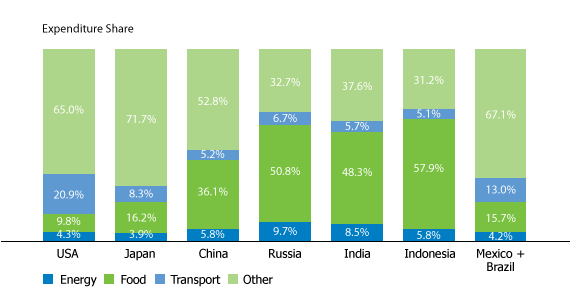The impact of humans on climate is shaped by choices such as what we eat, where we live, how we travel, and how we heat our homes. Research has shown that all of these consumption patterns are influenced by various demographic characteristics, yet most projections of future emissions and related climate impacts focus only on population size. Research in the Proceedings of the National Academy of Sciences examines population growth’s contribution to future emissions but also brings more demographic sophistication to climate modeling.
“Using a Population-Environment-Technology (PET) model allows for a better understanding of emissions’ futures,” says Brian O’Neill, a researcher from the National Center for Atmospheric Research and the study’s lead author.1 The PET model is grounded in an understanding that greenhouse gas emissions, key drivers of global climate change, are in large part the result of economic production processes (collection of raw materials, manufacturing, packaging, shipping, etc.) driven by consumption. Furthermore, both production and consumption are influenced by demographic dimensions, and integrating changing demographics into models represents a path to improved emissions forecasting and better climate scenarios.
Consumption is one focus of the PET model. The emissions scenarios developed by O’Neill and his colleagues consider future consumer demands for food, transportation, and energy. The research team drew upon surveys representing 34 countries for insight on regional variation in consumption patterns.
Consumption is also shaped by demographic factors such as aging and urbanization. For example, rural households in developing countries spend a larger share of their income on food and a smaller share on transportation than higher-income households in the United States. Thus, households differ in the amount of energy (and related emissions) required to produce daily consumables. The PET model integrates this nuance.
Household Expenditures in Four Categories for Initial Year of PET Emissions Simulation Model

Source: Brian O’Neill et al., “Global Demographic Trends and Future Carbon Emissions,” Proceedings of the National Academy of Sciences 107, no. 41 (2010): 17521-26.
Demographic factors also shape available labor supply and potential economic productivity. For example, households that are older, larger, or more rural tend to have lower per capita labor supply than those that are younger, smaller, or more urban. These characteristics affect a household’s earning potential and consumption patterns and ultimately affect economic production, greenhouse gas emissions, and climate change.
Bringing together consumption and production information, O’Neill and colleagues created detailed emissions scenarios for nine distinct global regions. To incorporate demographic size and composition into the PET model, population projections were created for each region by age, sex, and rural/urban residence for the period 2000 to 2100. These projections were then merged with an understanding of how compositional changes would influence consumption and labor supply and several sets of emissions projections were generated.
“The results show that population composition can have a significant influence on emissions, separate from the effect of changes in population size alone,” O’Neill states. For example, in industrialized regions, aging may reduce long-term emissions by up to 20 percent through decreased economic productivity and reduced consumption. Urbanization in less developed settings, however, may counteract these emissions reductions by yielding a 25 percent increase due to the increased consumption and economic productivity associated with urban living.
O’Neill’s research also suggests that slower population growth would substantially reduce global emissions, providing motivation for programs and policies that help women who want to space their births or limit their family size to access family planning and reproductive health services.2
Altogether, O’Neill’s research shows the importance of including demographic characteristics in addition to population size in emissions forecasts and climate scenarios. Promisingly, efforts are currently underway to improve the treatment of population in the forthcoming climate scenarios from the United Nations Intergovernmental Panel on Climate Change Report.